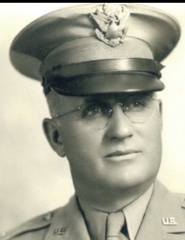Miles on Way to Pacific to Cover War
By Frank Miles
(Daily Times Herald War Correspondent)
Paris, France (IDPA) -- I am bound for China, the points in the Far East and Pacific, where I will cover American forces in action against the Japanese. I plan to complete that tour and return to the United States between Aug. 15 and Sept 1.
For several days I was with the National Commander Edward N. Schieberling of the American Legion, who has been talking with GIs to learn their minds for the future, viewing cemeteries reflective of the price paid in battle for American liberties and blessings, visiting wounded men to catch their reaction to their misfortune and seeing war's devastation that he may be stronger in his argument that lasting peace to the world could be realized.
At the 108th general hospital in Paris, he talked with many mangled men. One cheerfully said he wouldn't mind his condition if he were certain he could get a job through which he might earn a decent living. Many said they would not complain over their sacrifices if they might be assured baby boys would not have to go to war 20 or 25 years hence.
I was asked by an air force colonel who was an ace in the last war, if I knew whether bodies of Americans now buried in Germany would be removed. His reason for asking was that his only son was killed fighting as a pilot last New Year's eve, and buried in nazi land. What the government will do I don't know but if I have my way every soldier interred in Germany would be taken to France or Belgium or home, according to the wishes of the next of kin.
With Commander Schreiberling and others I flew to shattered Cherbourg from where we were motored to four beautiful cemeteries for World War II veterans -- Saint Mere Eglise 1 and 2, Blosville and La Cambe. Later we flew low over Saint Laurent.
Beneath a white wooden cross at Saint Mere Eglise No. 2 we found the grave of Theodore Roosevelt and at La Cambe that of Lesley J. McNair. They were generals in the army. There is no rank in death. The crosses stand only two feet above the ground with the horizontal piece only 18 inches in length.
Saint Laurent was the first American cemetery in France in World War II. It was laid out soon after the battle on the Normandy beaches. More than 900 bodies were there to be buried before the digging of the first grave was finished. A GI on graves duty turned over one body to find it was that of his only brother he thought was still in the states.
At La Cambe, Mancel Talcott, national graves registration chairman of the Legion, who accompanied Commander Scheiberling found a cross over a grave of a soldier from whose wife he had received a letter insisting her husband could not be dead. Talcott had the painful duty of writing her evidence of the youth's demise.
Every combat man I have interviewed wishes for everlasting peace. One who has fought and seen comrades fall in death or wounds or who has served in hospitals or burial details or who from his assignment knows the cost of war in blood and suffering favors any movement which will assure lasting tranquility. Most American youngsters don't like war but how they fight when they must. I could write when they must, I could write of many youths who griped plenty when their outfits were inactive but who became terrors to the nazis in battle.
After actually seeing action on fronts of the first, third, fifth, seventh and ninth armies and in the eighth, ninth, twelfth and fifteenth air forces, I am convinced that while your average American boy may not be so hot as a soldier on a lot of needless regulations, he is the most terrific fighter the world has ever known when he is called upon to march out and do or die.
Source: Carroll Daily Times Herald, July 6, 1945
![]()

